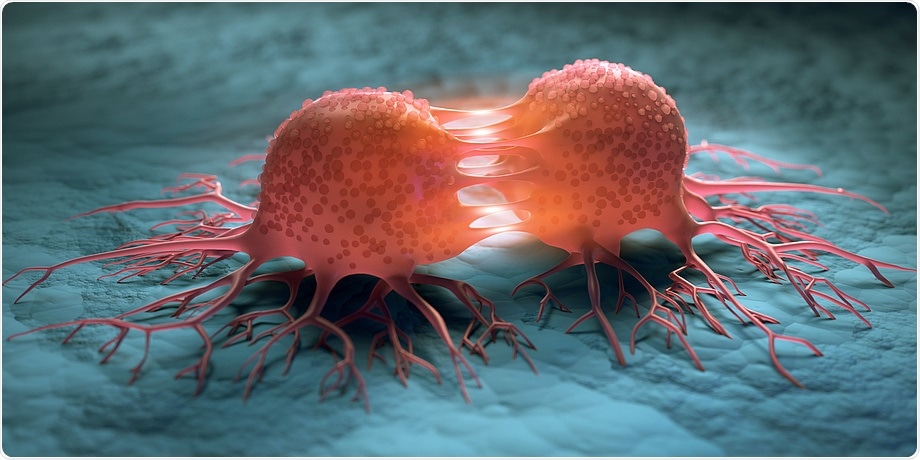For many years, computer models have been standard tools in fundamental biomedical research. Around 70 years after Hodgkin & Huxley published the first ion current model of a nerve cell in 1952, researchers at Graz University of Technology (TU Graz), in collaboration with the Medical University of Graz and the Memorial Sloan Kettering Cancer Center in New York, developed a new ion current model of a nerve cell.

With the first cancer cell model, researchers at TU Graz were able to launch an essential tool for modern cancer research and drug development. Pictured: a graphical representation of a dividing cancer cell. Image Credit: AdobeStock.
The team has finally created the world’s first cancer cell model, releasing “a vital tool for current cancer research and drug development,” according to Christian Baumgartner, who is overjoyed.
The senior author of the publication in which the digital model is presented in the journal PLOS Computational Biology is the head of the Institute of Health Care Engineering with the European Testing Center of Medical Devices at TU Graz.
Excitable and non-excitable cells
Excitable cells, such as nerve or cardiac muscle cells, have been the focus of digital cell models thus far, allowing simulation of electrophysiological events not only at the cellular level but also at the tissue and organ level.
These models are already being utilized in clinical practice to help with diagnosis and treatment. For the first time, a multinational research team led by Baumgartner concentrated on the electrophysiological features of non-excitable cancer cells.
An electrical stimulus causes action potentials to form in excitable cells. This causes millisecond-long variations in electrical potential at the cell membrane, which transport “electrical” information from one cell to the next.
Neural networks communicate or the heart muscle is engaged and contracts as a result of this mechanism. Experimental studies have shown that “non-excitable” cells also have distinctive potential fluctuations at the cell membrane.
However, compared to excitable cells, the potential changes occur very slowly and over the entire cell cycle, i.e. over hours and days, and serve as a signal for the transition between the individual cell cycle phases.”
Christian Baumgartner, Study Senior Author, Graz University of Technology
Christian Baumgartner was the first to investigate the concept of constructing a simulation model of these systems, working with the institute’s deputy head, Theresa Rienmüller, and Ph.D. student Sonja Langthaler.
Lung tumor example
Changes in cell membrane voltage that are pathological, especially during the cell cycle, are critical for cancer formation and progression.
Ion channels connect the outside to the inside of a cell. They enable the exchange of ions such as potassium, calcium or sodium and thereby regulate the membrane potential. Changes in the composition of ion channels, as well as altered functional behavior of the same, can result in disruptions in cell division, possibly even affecting cell differentiation and thus transforming a healthy cell into a diseased (carcinogenic) cell.”
Sonja Langthaler, PhD Student, Graz University of Technology
The scientists used the human lung adenocarcinoma cell line A549 as the basis for their digital cancer cell model. The computer model simulates the cyclic oscillation of membrane potential during the transition between cell cycle phases and allows for the prediction of changes in membrane potential caused by drug-induced ion channel switching on and off.
So we get information about the effects of targeted interventions on the cancer cell.”
Christian Baumgartner, Study Senior Author, Graz University of Technology
“Freezing” cancer cells during growth or inducing them to commit suicide
Certain ion channels’ activity can also induce the division of sick cells, speeding up tumor growth. The cell membrane voltage, and hence the entire electrophysiological system, can be thrown off track if ion channels are now altered in a targeted manner, as is the case with new, promising agents and medications.
“This could be used to arrest cancer cells at a certain phase in the cell cycle, but also to induce premature cell death (apoptosis). One could "freeze" cancer cells while they are growing or induce them to commit suicide. And it is precisely such mechanisms that can be simulated with the help of models,” said Baumgartner.
The first digital cancer cell model, according to Baumgartner and his colleagues, is just the beginning of more detailed research. Plans for additional experimental and measurement validations have been created and submitted to the Austrian Science Fund FWF for funding to expand the model’s level of detail.
Source:
Journal reference:
Langthaler, S., et al. (2021) A549 in-silico 1.0: A first computational model to simulate cell cycle dependent ion current modulation in the human lung adenocarcinoma. PLOS Computational Biology. doi.org/10.1371/journal.pcbi.1009091.